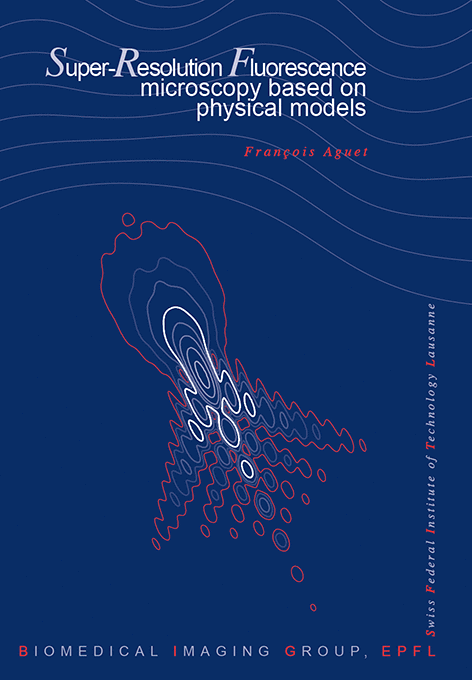Super-Resolution Fluorescence Microscopy Based on Physical Models
F. Aguet
SSBE research award, École polytechnique fédérale de Lausanne, EPFL Thesis no. 4418 (2009), 209 p., May 28, 2009.
This thesis introduces a collection of physics-based methods for super-resolution in optical microscopy. The core of these methods constitute a framework for 3-D localization of single fluorescent molecules. Localization is formulated as a parameter estimation problem relying on a physically accurate model of the system's point spread function (PSF). In a similar approach, methods for fitting PSF models to experimental observations and for extended-depth-of-field imaging are proposed.
Imaging of individual fluorophores within densely labeled samples has become possible with the discovery of dyes that can be photo-activated or switched between fluorescent and dark states. A fluorophore can be localized from its image with nanometer-scale accuracy, through fitting with an appropriate image function. This concept forms the basis of fluorescence localization microscopy (FLM) techniques such as photo-activated localization microscopy (PALM) and stochastic optical reconstruction microscopy (STORM), which rely on Gaussian fitting to perform the localization. Whereas the image generated by a single fluorophore corresponds to a section of the microscope's point spread function, only the in-focus section of the latter is well approximated by a Gaussian. Consequently, applications of FLM have for the most part been limited to 2-D imaging of thin specimen layers.
In the first section of the thesis, it is shown that localization can be extended to 3-D without loss in accuracy by relying on a physically accurate image formation model in place of a Gaussian approximation. A key aspect of physically realistic models lies in their incorporation of aberrations that arise either as a consequence of mismatched refractive indices between the layers of the sample setup, or as an effect of experimental settings that deviate from the design conditions of the system. Under typical experimental conditions, these aberrations change as a function of sample depth, inducing axial shift-variance in the PSF. This property is exploited in a maximum-likelihood framework for 3-D localization of single fluorophores. Due to the shift-variance of the PSF, the axial position of a fluorophore is uniquely encoded in its diffraction pattern, and can be estimated from a single acquisition with nanometer-scale accuracy.
Fluroescent molecules that remain fixed during image acquisition produce a diffraction pattern that is highly characteristic of the orientation of the fluorophore's underlying electromagnetic dipole. The localization is thus extended to incorporate the estimation of this 3-D orientation. It is shown that image formation for dipoles can be represented through a combination of six functions, based on which a 3-D steerable filter for orientation estimation and localization is derived. Experimental results demonstrate the feasibility of joint position and orientation estimation with accuracies of the order of one nanometer and one degree, respectively. Theoretical limits on localization accuracy for these methods are established in a statistical analysis based on Cramér-Rao bounds. A noise model for fluorescence microscopy based on a shifted Poisson distribution is proposed.
In these localization methods, the aberration parameters of the PSF are assumed to be known. However, state-of-the-art PSF models depend on a large number of parameters that are generally difficult to determine experimentally with sufficient accuracy, which may limit their use in localization and deconvolution applications. A fitting algorithm analogous to localization is proposed; it is based on a simplified PSF model and shown to accurately reproduce the behavior of shift-variant experimental PSFs.
Finally, it is shown that these algorithms can be adapted to more complex experiments, such as imaging of thick samples in brightfield microscopy. An extended-depth-of-field algorithm for the fusion of in-focus information from frames acquired at different focal positions is presented; it relies on a spline representation of the sample surface and as a result yields a continuous and super-resolved topography of the specimen.

@PHDTHESIS(http://bigwww.epfl.ch/publications/aguet0903.html,
AUTHOR="Aguet, F.",
TITLE="Super-Resolution Fluorescence Microscopy Based on Physical
Models",
SCHOOL="{\'{E}}cole polytechnique f{\'{e}}d{\'{e}}rale de {L}ausanne
({EPFL})",
YEAR="2009",
type="{EPFL} Thesis no.\ 4418 (2009), 209 p.",
address="",
month="May 28,",
note="{SSBE} research award")